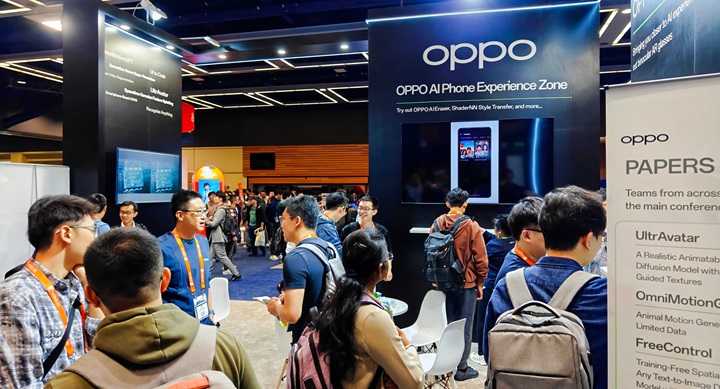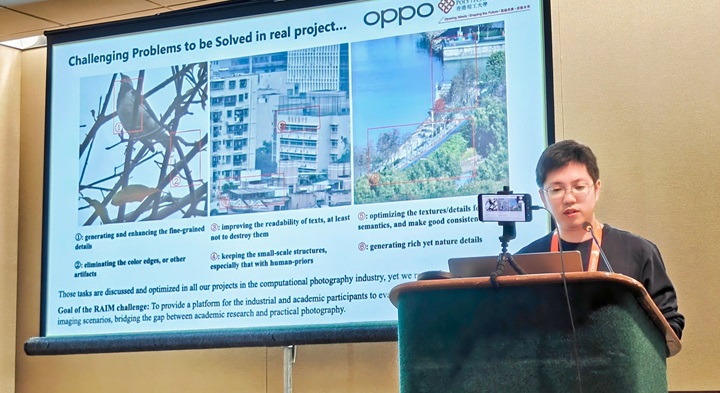The prestigious CVPR (Conference on Computer Vision and Pattern Recognition), a leading global event in computer vision, officially commenced in Seattle. This year, OPPO made a significant impact with several of its latest research papers being selected for presentation, encompassing a range of AI-related topics. Moreover, OPPO’s flagship AI phone, the Find X7 Ultra, and the newly launched OPPO Reno12 were demoed at the conference, showcasing numerous innovative AI phone features. Through these contributions, OPPO continues to influence the global advancement and democratization of AI phone.

“OPPO is deeply engaged in the CVPR each year, and this year, our achievements are particularly noteworthy,” stated Billy Zhang, President of Overseas MKT, Sales and Service at OPPO. “AI has always been a pivotal area of investment for us, and the rising trend of AI phone enables us to innovate the user experience once again. CVPR provides an excellent platform for OPPO to discuss and exchange ideas with global partners about our latest advancements in computer vision and other AI-related fields. Our involvement in CVPR also underscores OPPO’s strong commitment and determination in the realm of AI phone.”
With Major Papers Selected for Conference, OPPO AI Research is Flourishing
This year, OPPO Research Institute and various R&D teams achieved significant recognition with 11 papers selected for presentation at CVPR. These papers span key research areas including image restoration, digital human generation, video segmentation, dynamic motion capture, dynamic scene image synthesis, multi-view 3D object detection, and 3D rendering, highlighting some of the most innovative directions in AI phone.
In the field of digital human generation, OPPO has introduced a groundbreaking approach with UltrAvatar—a method for creating drivable 3D virtual humans. Utilizing a diffuse color extraction model and an authenticity-guided texture diffusion model, UltrAvatar can generate drivable 3D virtual humans from a single image or a line of text. These virtual humans are indistinguishable from real human features, achieving a level of detail that captures every inch of skin color and texture on a person’s face, significantly enhancing the realism of virtual interactions.
Another notable contribution, the UniVS, presents the industry’s first universal large model for video segmentation. This model is uniquely capable of meeting diverse real-world video segmentation needs, allowing for the segmentation of all objects within a specified category and responding to textual descriptions for targeted segmentation.
These selected papers not only represent cutting-edge advancements in AI but also position OPPO as a leader propelling the mobile industry into the AI-driven era.
Additionally, the CVPR 2024 NTIRE RAIM (Restore Any Image Model) challenge, co-organized by OPPO Research Institute’s Y-Lab and the Visual Computing Laboratory at the Hong Kong Polytechnic University, was a resounding success. This challenge encouraged researchers to address real-world industrial challenges, develop methods for accurate high-quality image restoration, and promote the application of these technologies in industry. The NTIRE RAIM challenge attracted participation from over 200 teams globally. And finally, Team MiAlgo’s research emerged as the winner, clinching first place in the competition.
Going forward, OPPO will robustly support the AI developer ecosystem, fostering close academia-industry collaboration to bridge the two.
Find X7 Ultra Debuts at CVPR, Sparking Interest in AI Phone Innovation
OPPO’s flagship AI phone, the Find X7 Ultra, made a remarkable debut, quickly becoming a highlight of the event. Additionally, Liang Jie, the senior imaging algorithm engineer at OPPO Research Institute’s Y-Lab, was invited to present a report on OPPO’s imaging technology at the conference. The powerful AI imaging capabilities of the Find X7 Ultra and OPPO’s innovative generative AI applications captivated both the academic and industrial AI communities.

This year signifies OPPO’s official foray into the AI phone era, with the Find X7 Ultra emerging as the most advanced AI phone from OPPO to date. It boasts the OPPO HyperTone Image Engine, the most sophisticated computational photography system currently on the market. This engine enables OPPO Find X7 Ultra to produce exceptional photos with minimal computational footprint, turning every shot into a masterpiece.
The OPPO AI Eraser feature, launched alongside the Find X7 Ultra, showcased to CVPR attendees OPPO’s ability to seamlessly integrate AI technology into consumer devices for user-friendly experiences. The OPPO AI Eraser allows users to easily remove unwanted elements from an image and generate replacement content with a single click. Since its introduction, this feature has revolutionized photo editing, averaging 15 uses per day per user, making it one of the most popular features.
OPPO also showcased several exploratory features through real device demos at CVPR, highlighting the future direction of OPPO’s AI technologies. Among these was the Style Transfer Demo, which utilizes the ShaderNN lightweight deep learning architecture. ShaderNN represents the first inference engine supporting the full graphics stack (OpenGL & Vulkan) for real-time mobile graphics and imaging applications, showcasing OPPO’s strengths in on-device generative graphics AI processing.
Solidifying Foundations, Continuously Promoting the Democratization of AI Phone
At the beginning of the year, OPPO strategically established OPPO AI Center, directing company resources towards enhancing AI capabilities. This initiative has not only integrated and strengthened OPPO’s research across various AI fields but also aimed to deliver the ultimate AI phone experience. It has bolstered OPPO’s technical foundation in the AI phone sector and showcased impressive research outcomes at this year’s CVPR.
This year’s CVPR also marks OPPO’s continued presence at top international AI conferences, following the participation at events such as MWC, Google Cloud Next ’24, and Microsoft Build. OPPO is actively collaborating with global partners to advance the development of AI phones.
In early June, OPPO officially announced its strategy to make AI phones accessible to everyone, targeting the equipping of approximately 50 million OPPO smartphones with generative AI features by year’s end, spanning all OPPO’s smartphone product lines. This move underscores OPPO’s long-term commitment and strategic determination to enhance AI integration in smartphones.
Looking forward, the innovative research outcomes from OPPO, combined with advanced technologies from partners like Google, Microsoft and MediaTek, will further propel OPPO’s mission to spearhead a global movement in the democratization of AI phone.

